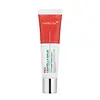What's inside
What's inside
 Key Ingredients
Key Ingredients

No key ingredients
 Benefits
Benefits

 Concerns
Concerns

 Ingredients Side-by-side
Ingredients Side-by-side

Water
Skin ConditioningButylene Glycol
HumectantDipropylene Glycol
HumectantGlycol
HumectantGlyceryl Stearate
EmollientGlycerin
HumectantCetearyl Alcohol
Emollient1,2-Hexanediol
Skin ConditioningCyclopentasiloxane
EmollientCyclohexasiloxane
EmollientAsiaticoside
AntioxidantMadecassic Acid
Skin ConditioningAsiatic Acid
Skin ConditioningTriethanolamine
BufferingCarbomer
Emulsion StabilisingWater
Skin ConditioningPetrolatum
EmollientGlycerin
HumectantButylene Glycol
HumectantCarthamus Tinctorius Seed Oil
MaskingLimnanthes Alba Seed Oil
Skin ConditioningHydrogenated Polyisobutene
EmollientPPG-2 Myristyl Ether Propionate
EmollientCyclopentasiloxane
EmollientLinum Usitatissimum Seed Oil
PerfumingButyrospermum Parkii Butter
Skin ConditioningCetyl Alcohol
EmollientCetearyl Glucoside
EmulsifyingC10-30 Cholesterol/Lanosterol Esters
EmulsifyingCyclohexasiloxane
EmollientAcrylates/C10-30 Alkyl Acrylate Crosspolymer
Emulsion StabilisingAllium Fistulosum Bulb Extract
Skin ConditioningArachidyl Alcohol
EmollientArachidyl Glucoside
EmulsifyingBehenyl Alcohol
EmollientBeeswax
Emulsion StabilisingC12-15 Alkyl Benzoate
AntimicrobialCaprylyl Glycol
EmollientCyclomethicone
EmollientDimethiconol
EmollientDisodium EDTA
Ethylhexylglycerin
Skin ConditioningGlyceryl Stearate
EmollientHexylene Glycol
EmulsifyingOlea Europaea Oil Unsaponifiables
Skin ConditioningPEG-100 Stearate
Persea Gratissima Oil
Skin ConditioningPhenoxyethanol
PreservativePhytosphingosine
Skin ConditioningPhytosterols
Skin ConditioningRosa Canina Fruit Oil
EmollientTriethanolamine
BufferingWater, Petrolatum, Glycerin, Butylene Glycol, Carthamus Tinctorius Seed Oil, Limnanthes Alba Seed Oil, Hydrogenated Polyisobutene, PPG-2 Myristyl Ether Propionate, Cyclopentasiloxane, Linum Usitatissimum Seed Oil, Butyrospermum Parkii Butter, Cetyl Alcohol, Cetearyl Glucoside, C10-30 Cholesterol/Lanosterol Esters, Cyclohexasiloxane, Acrylates/C10-30 Alkyl Acrylate Crosspolymer, Allium Fistulosum Bulb Extract, Arachidyl Alcohol, Arachidyl Glucoside, Behenyl Alcohol, Beeswax, C12-15 Alkyl Benzoate, Caprylyl Glycol, Cyclomethicone, Dimethiconol, Disodium EDTA, Ethylhexylglycerin, Glyceryl Stearate, Hexylene Glycol, Olea Europaea Oil Unsaponifiables, PEG-100 Stearate, Persea Gratissima Oil, Phenoxyethanol, Phytosphingosine, Phytosterols, Rosa Canina Fruit Oil, Triethanolamine
Ingredients Explained
These ingredients are found in both products.
Ingredients higher up in an ingredient list are typically present in a larger amount.
Butylene Glycol (or BG) is used within cosmetic products for a few different reasons:
Overall, Butylene Glycol is a safe and well-rounded ingredient that works well with other ingredients.
Though this ingredient works well with most skin types, some people with sensitive skin may experience a reaction such as allergic rashes, closed comedones, or itchiness.
Learn more about Butylene GlycolCyclohexasiloxane is a type of silicone more commonly known as D6. It is an emollient and solvent.
Cyclohexasiloxane is used to evenly distribute ingredients throughout the product. When applied to the skin, Cyclohexasiloxane evaporates and leaves behind a silky feel.
As an emollient, it can help the skin feel soft and hydrated. It is also used to reduce frizz in hair products.
Learn more about CyclohexasiloxaneCyclopentasiloxane, or D5, is a silicone used to improve texture of products and trap moisture.
D5 is considered lightweight and volatile. Volatile means it evaporates quickly after application. Once evaporated, D5 leaves a thin barrier that helps keep skin hydrated.
It is also an emollient. Emollients help soften the skin and prevent water loss. Silicones create a silky texture in products. D5 helps other ingredients become more spreadable.
Studies show D5 is safe to use in skincare products. We recommend speaking with a skincare professional if you have concerns.
Learn more about CyclopentasiloxaneGlycerin is already naturally found in your skin. It helps moisturize and protect your skin.
A study from 2016 found glycerin to be more effective as a humectant than AHAs and hyaluronic acid.
As a humectant, it helps the skin stay hydrated by pulling moisture to your skin. The low molecular weight of glycerin allows it to pull moisture into the deeper layers of your skin.
Hydrated skin improves your skin barrier; Your skin barrier helps protect against irritants and bacteria.
Glycerin has also been found to have antimicrobial and antiviral properties. Due to these properties, glycerin is often used in wound and burn treatments.
In cosmetics, glycerin is usually derived from plants such as soybean or palm. However, it can also be sourced from animals, such as tallow or animal fat.
This ingredient is organic, colorless, odorless, and non-toxic.
Glycerin is the name for this ingredient in American English. British English uses Glycerol/Glycerine.
Learn more about GlycerinGlyceryl Stearate is a mix of glycerin and stearic acid.
It is used to stabilize the mixing of water and oil ingredients. By preventing these ingredients from separating, it can help elongate shelf life. It can also help thicken the product's texture.
As an emollient, it helps soften skin and supports barrier-replenishing ingredients.
In cosmetics, Glyceryl Stearate is often made from vegetable oils or synthetically produced.
This ingredient may not be fungal-acne safe
Fun fact: The human body also creates Glyceryl Stearate naturally.
Learn more about Glyceryl StearateTriethanolamine is an emulsifier and pH adjuster. It is created using ethylene oxide and ammonia. This gives Triethanolamine a nitrogen core and a similar scent to ammonia.
As an emulsifier, it prevents ingredients from separating and enhances texture by adding volume to a product.
PH adjusters are common in cosmetic products. The pH of a product can affect the effectiveness of other ingredients. A product with a high pH may also irritate the skin.
Learn more about TriethanolamineWater. It's the most common cosmetic ingredient of all. You'll usually see it at the top of ingredient lists, meaning that it makes up the largest part of the product.
So why is it so popular? Water most often acts as a solvent - this means that it helps dissolve other ingredients into the formulation.
You'll also recognize water as that liquid we all need to stay alive. If you see this, drink a glass of water. Stay hydrated!
Learn more about Water